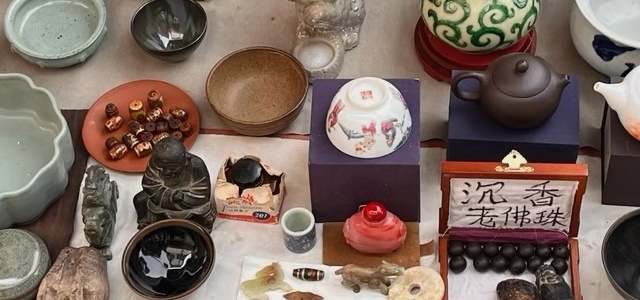Hubu Mountain is outside of the South Gate of the ancient city Xuzhou, my hometown. Today it is part of the downtown core with 900,000 people. To call it a mountain is an overstatement. It is more like a hill, although you will break a sweat climbing up. Its commanding view has a perk – When the Yellow River was still a monster to tame during flooding seasons, the water would not reach the height. During the Ming Dynasty, this was a safe place for wealthy people to build big houses with magnificent courtyards. From afar, their tall exterior walls intersect with each other and cascade down the hill, forming a rich tapestry in deep blue, charcoal black, and here and there, a hint of red. On a quiet weekday, the neighborhood provides a great place to walk and soak in history and architecture.
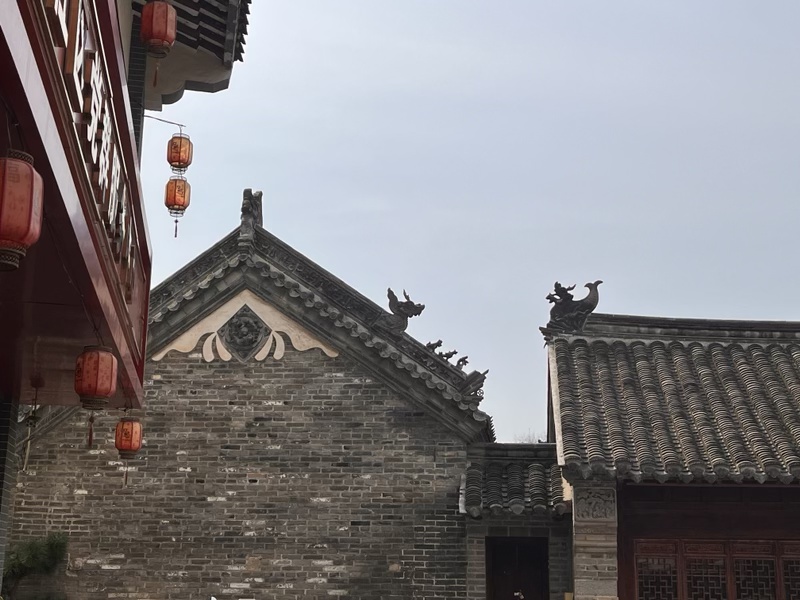
Not on weekends! During the weekend, Hubu Mountain hosts one of the most vibrant antiques markets in the region. About ten years ago, the market was near the South Gate but the local government forced it to move to a new district where few people lived. Gradually, dealers came back to the city near Hubu Mountain. Its central location lured more and more visitors every year. Eventually, its momentum became unstoppable such that the city gave in and recognized its legitimacy. Nowadays, under the curved rooflines decorated with gargoyles, there are easily a few hundred dealers lined up along the pebble-stone alley roads, greeting and arguing with thousands of visitors.
Today I am one of them.
Antiquing in Chinese is called Tao Bao, which means finding treasure. While street vendors are taking center stage, it is easy to miss that the commercial buildings behind them are mostly brick-and-mortar antiques stores, with steep price tags. They don’t attract much foot traffic during the weekends as most collectors are here with one particular task in mind – Jian Lou, which means picking up something others have overlooked.
Indeed, most street vendors promise no provenance and guarantee no authenticity. In exchange, they offer low prices and invite bargaining. That is enough draw for collectors. I was pumped to find out whether the luck would be with me to pick up something overlooked.
The market is not strictly antiques. It has a bit of everything — from flowers and goldfish to artisan baskets and handmade jewelry. But the predominant category is second-hand objects from at least a few decades ago. Given how fast China has developed since the 1980s, that sounds like ancient history.
My first stop was at a plain-clothed clock vendor, who spoke a different dialect. The dress code is by choice. For vendors, dressing down projects an air of being unseasoned and undertrained, from whom overlooked treasures are more likely to be offered as a bargain. Visitors certainly don’t want to be flagged as being affluent, inviting a mark-up price at every turn. The uniformity in dress has its downside. One can easily get lost among a steady stream of people in black and gray under the blue-toned gray walls.
“Antiques clocks should not be photographed,” the vendor demanded when I finally squeezed in to take a picture. Mechanical clocks first arrived in China from Europe during the Qing Dynasty. They were luxury items to a county that still ran time-keeping on sundials and central clock towers. The one that quickly attracted a crowd offered a unique movement with a ball rolling down zigzag grooves on an inclined plane. I cannot recall whether I have seen a similar one in the Forbidden City Museum, but I understand how those emperors got hooked, just like the rest of us, with our eyes glued to the movement. Suddenly, the passage of time is physically tangible and visually tantalizing.
I stopped by Master Ma’s booth because he was painting a commissioned portrait of a bulldog in watercolor, not to be distracted by the crowd. Well, I could not let go of an opportunity to have my dog painted on a fan for around $10! “Your dog is easy, “ said Master Ma, after he connected with me on WeXin (a Chinese version of Facebook) and received a photo of my dog. “I can finish it within an hour. Why don’t you continue strolling?”
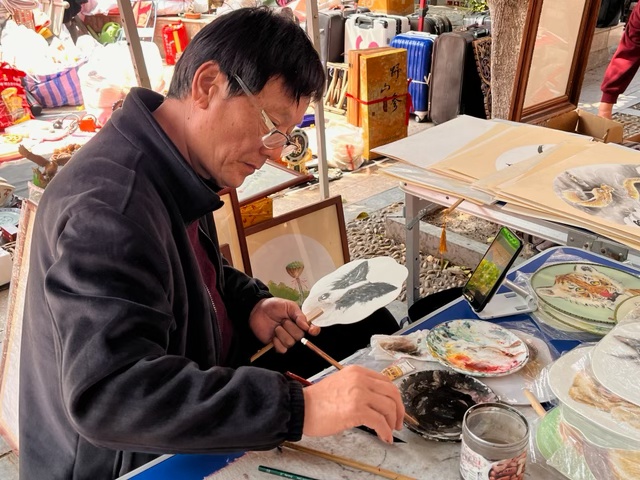
Nearby, a young man was carving custom seals onsite. He offers one for less than seven dollars, including materials and labor. While stamping is not required for daily activities, it is still considered a necessity for Chinese intellectuals and antique collectors. They are like shoes. You cannot just have one. There are usually different ones for different occasions. And the more, the merrier. At the market, he found many potential patrons and was constantly busy answering inquiries and explaining seal design.
Most of the seals are carved into soapstone in seal script. Or, should I say the type of script that I cannot read? “What does this one say?” I picked up a seal with interesting calligraphy but was disappointed with his answer. “Oh, I actually don’t know. I found the ancient script online and decided to copy it.”
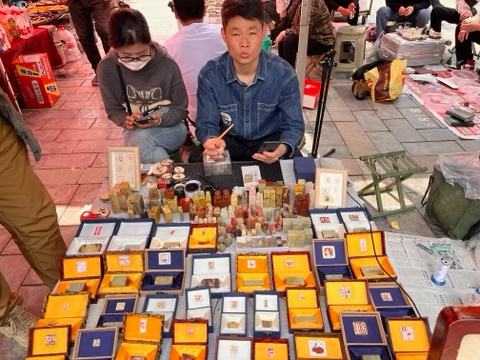
I realized that he was young. Perhaps in his early ’20s. He may have mastered the skill of carving, but it takes years to build that knowledge. “I usually don’t carve here. It is too noisy, plus I have to answer questions.” He told me when I asked how long it would take him to finish. “I probably can do it within two or three hours. But I am kind of OCD. I cannot be rushed. If I don’t like it, I have to redo it. It’s much easier if I make it home where I can concentrate.”
A woman who operates a store had all her small porcelain cups on the street. “One scan for one pick, 10 RMB each.” (In China, mobile payment is ubiquitous. All you need is to scan a 2D barcode for payment.) With the price tag of about $1.50 each, I could not help checking them out even though they are new.
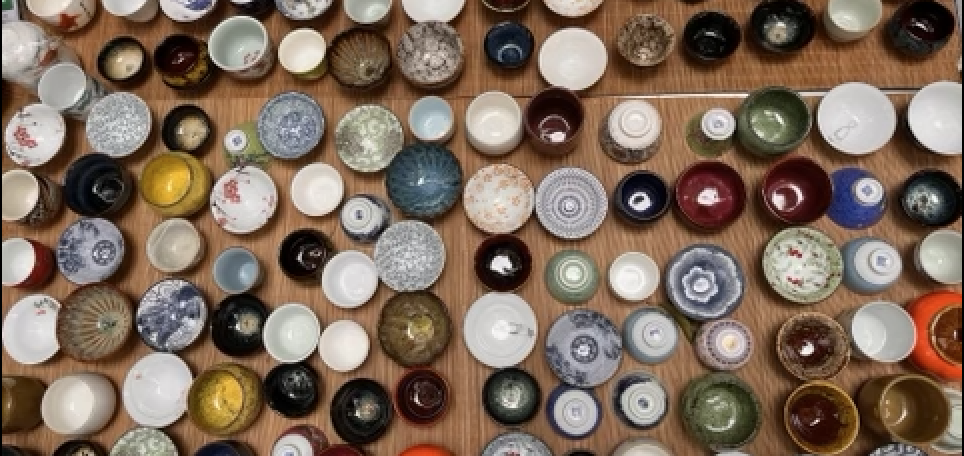
Her strategy worked. I observed that it was one of the most visited booths because of the price transparency and affordability. The cups vary in size, colors, and techniques. I happened to pick up a pair of imitating cabbages. In China, a “cabbage price” means a bargain; so I thought it is appropriate to have the form to match the price.
A vendor from Baoding, Hebei Province told me that it was his first time exhibiting at the market. He must finish early to catch a 4 o’clock train to Jinan, a northern city 200 miles away. That piece of information, I warned myself, should always be discounted. Often vendors give reasons that put themselves at a disadvantage to invite a bid. A pair of octagon porcelain shallow plates with fish and tape grass looked interesting. But their bottoms are not glazed – a practice that I am not sure was well adopted in the past. Soon my eyes landed on a brush holder. The enameled porcelain features many children in play. He asked for $85. I decided to leverage the abundance of similar items against his offer; so I moved on.
Then I met my nemesis. First, I found the “treasure” of the day. A tiny cup is painted both inside and outside with pastel colors and delicate details. The picture is rather naïve if not crude. But I have found it quite charming with gestural and facial language from figures of different ages and backgrounds. The most amazing part is its thinness. Against the sun, I could almost see light and then realized there were hairline cracks in many places (but none of them were through). All the evidence pointed to a quality commercial kiln before 1900. Then I heard the verdict – “You have good eyes. It is rare. For you, it is 2800 RMB.” That’s just shy of $400. Well, the treasure is definitely not overlooked, but I had to search elsewhere to fit in my budget.
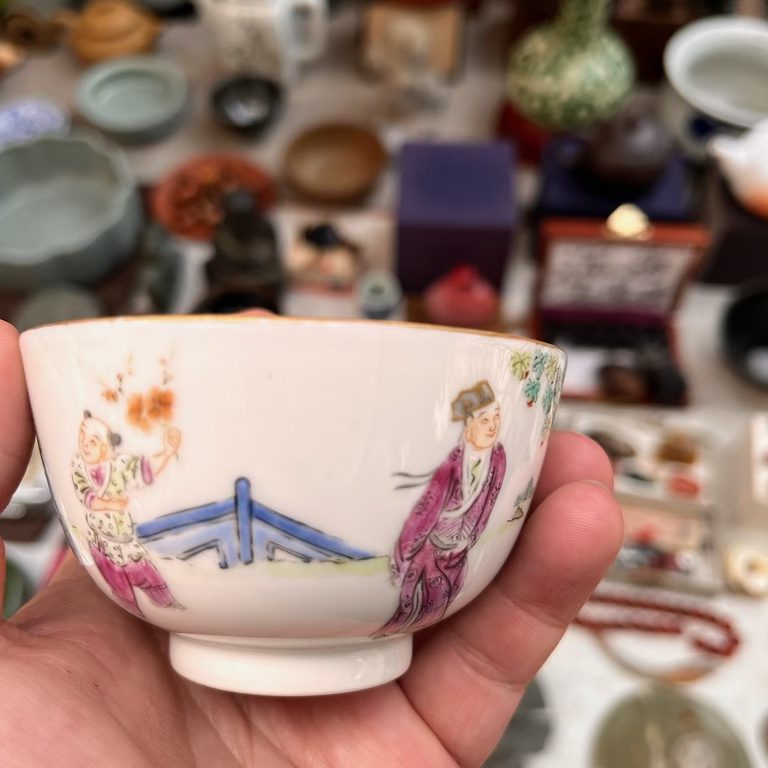
I found another two brush holders from the same vendor. Soon I began to realize he was quite educated in the business, with the type of vocabulary and confidence you would expect from an expert. “This is likely from the Kangxi period, a pinnacle period for blue and white porcelain. It is not from an official kiln. The stark contrast of the blue against white, and the exquisite depth from the lighter shade of blue to the darker one is truly unique in that period. The overglaze (Bao Jiang) is perfect and the condition is near perfect except for the normal wear. It is well worth RMB600!” That is about $85.
I agreed with him on everything he said except the suggested period. The inking style is a hallmark of Kangxi period, such that it is widely copied in the modern era. I did not bring any equipment to examine the age. (Even if I did, I probably would not be able to use it properly.) But I do know that a true Kangxi period brush holder would fetch more in an auction while a reproduction can be bought for just five bucks. I doubted that such an erudite dealer would overlook and undervalue a great piece. So it is likely to be the latter case.
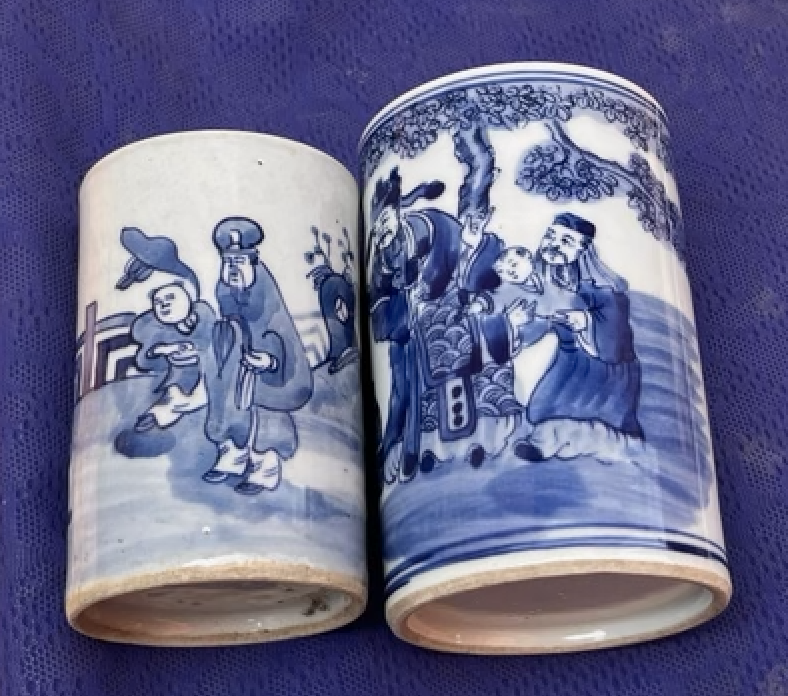
Next to it was another one that caught my eye. The dealer continued his upsell pitch, “well, it is smaller, with some defects. The color is not as strong. Probably after the Republic period (1911).” At the bottom, there are areas where the white glaze was not applied properly. In a technical term, it was called “Suo You”, or shrinking glaze. I noticed the oxidation of the areas and thought while the defects show that it is not of the highest quality, at least they look genuine. Then, perhaps the vendor took the cue and changed his selling strategy. He redirected me to the painting, “But look, the figures are rather lively. It will make you smile. You can get this bargain at 380RMB.”
In the end, I practiced my bargaining skills a little bit and took home by paying much less than the original asking price. On the way back, I also picked up the dog portrait by Master Ma. Many bystanders said the dog looked spirited. Neither the brush holder nor the portrait would be considered a treasure based on its rarity or quality; and nowhere were they overlooked. Still I am happy with my Tao Bao. Every bit of them is a treasure, in my own experience and memory.
Discover more from Urban Art & Antiques
Subscribe to get the latest posts sent to your email.

